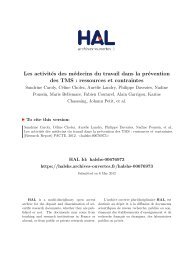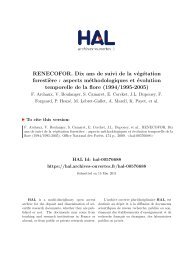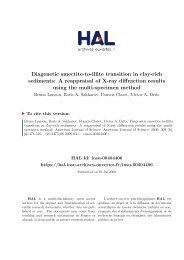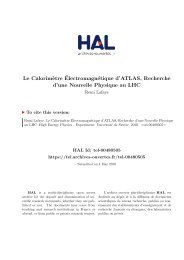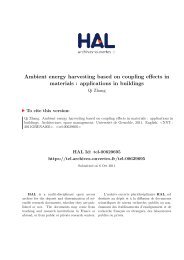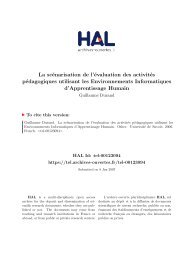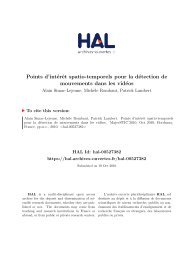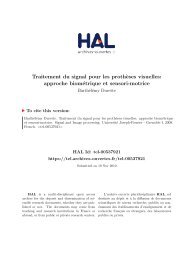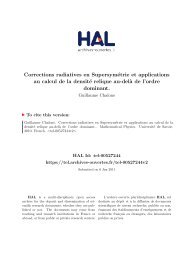Modélisation, analyse mathématique et numérique de divers ...
Modélisation, analyse mathématique et numérique de divers ...
Modélisation, analyse mathématique et numérique de divers ...
Create successful ePaper yourself
Turn your PDF publications into a flip-book with our unique Google optimized e-Paper software.
Mo<strong>de</strong>ling, mathematical and numerical analysis of various compressible<br />
or incompressible flows in thin layer<br />
Abstract<br />
In the first part, we formally <strong>de</strong>rive the PFS (Pressurised and Free Surface) equations<br />
for unsteady mixed flows in closed water pipes with variable geom<strong>et</strong>ry. We write the numerical<br />
approximation of these equations by a VFRoe and a kin<strong>et</strong>ic solver by upwinding the sources<br />
terms at the cell interfaces. Particularly, we propose the upwinding of a friction term (given by<br />
the Manning-Strickler law) by introducing the notion of dynamic slope. Finally, we construct<br />
a well-balanced scheme preserving the still water steady states by <strong>de</strong>fining a stationary matrix<br />
especially constructed for the VFRoe scheme. Following this i<strong>de</strong>a, we construct a well-balanced<br />
scheme which preserve all steady states.<br />
To <strong>de</strong>al with transition points occurring when the state of the flow changes (i.e. free surface<br />
to pressurised and conversely), we extend the « ghost waves » m<strong>et</strong>hod and propose a full kin<strong>et</strong>ic<br />
approach.<br />
In the second part, we study a simplified version of a compressible primitive equations for<br />
the dynamic of the atmosphere. We obtain an existence result for weak solutions global in time<br />
for the two-dimensional mo<strong>de</strong>l. We also state a stability result for weak solutions for the three<br />
dimensional version. To this end, we introduce a useful change of variables which transform the<br />
initial mo<strong>de</strong>l in a more simpler one.<br />
We present a small introduction to the cavitation phenomena. We recall the different kinds<br />
of cavitation and some mathematical mo<strong>de</strong>ls such as the Rayleigh-Pless<strong>et</strong> equation and a mixed<br />
mo<strong>de</strong>l. As a first step toward the mo<strong>de</strong>ling of the cavitation in closed pipes, we propose a bilayer<br />
mo<strong>de</strong>l which take into account the compressibility effect of the air onto the free surface. As<br />
pointed out by several authors, such a system, of 4 equations, is non hyperbolic and generally,<br />
eigenvalues cannot be explicitly computed. We propose a numerical approximation by using a<br />
kin<strong>et</strong>ic scheme.<br />
In the last chapter, we formally <strong>de</strong>rive a sediments transport mo<strong>de</strong>l based on the Vlasov<br />
equation coupled to an anisotropic compressible Navier-Stokes equations. This mo<strong>de</strong>l is obtained<br />
by performing two asymptotic analysis.<br />
Keywords: Unsteady mixed flows in closed water pipes, Shallow water equations (Saint-Venant),<br />
Pressurised equations, Finite Volume, VFRoe solver, Kin<strong>et</strong>ic solver, Well-balanced scheme, Compressible<br />
primitive equations, Existence and stability results, Anisotropic compressible Navier-<br />
Stokes equations, Cavitation, Bilayer mo<strong>de</strong>l, Saint-Venant-Exner equations.<br />
vi



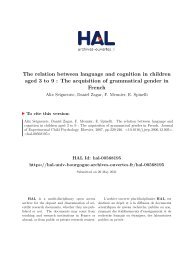
![[inria-00494734, v1] Genèse et estimation d'un modèle de ... - HAL](https://img.yumpu.com/50826406/1/184x260/inria-00494734-v1-genase-et-estimation-dun-modale-de-hal.jpg?quality=85)

